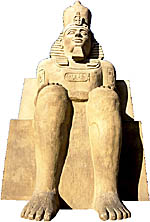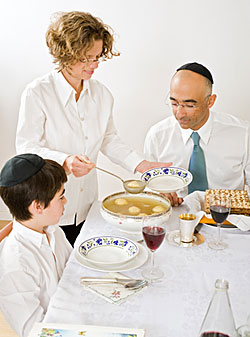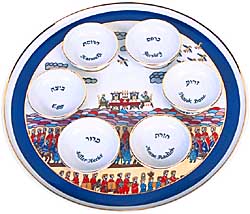What is…
The Passover and why is it significant
also known as: The Feast of Unleavened Bread and Seder
 Watch a short film segment (8 min.) which beautifully depicts and describes the first Passover and the historic events leading up to it and immediately following it. GO…
Watch a short film segment (8 min.) which beautifully depicts and describes the first Passover and the historic events leading up to it and immediately following it. GO…
Introduction
Passover is the name given to the chief of the three great historical annual festivals of the Jews. It was kept in remembrance of the Lord’s passing over the houses of the Israelites (Exodus 12:13) when the first born of all the Egyptians were destroyed

It is called also the “feast of unleavened bread” (Exodus 23:15; Mark 14:1; Acts 12:3), because during its celebration no leavened bread was to be eaten or even kept in the household (Exodus 12:15). The word afterwards came to denote the lamb that was slain at the feast (Mark 14:12-14; 1 Corinthians 5:7).
A detailed account of the institution of this feast is given in Exodus 12 and 13.
It was afterwards incorporated in the ceremonial law (Leviticus 23:4-8) as one of the great festivals of the nation.

In after times many changes seem to have taken place as to the mode of its celebration as compared with its first celebration (compare Deuteronomy 16:2,5,6; 2 Chronicles 30:16; Leviticus 23:10-14; Numbers 9:10,11; 28:16-24). Again, the use of wine (Luke 22:17, 20), of sauce with the bitter herbs (John 13:26), and the service of praise were introduced.
There is recorded only one celebration of this feast between the Exodus and the entrance into Canaan, namely, that mentioned in Numbers 9:5. (See JOSIAH.)

It was primarily a commemorative ordinance, reminding the children of Israel of their miraculous deliverance out of Egypt; but it was, no doubt, also a type of the great deliverance wrought by the Messiah for all his people from the doom of death on account of sin, and from the bondage of sin itself, worse than Egyptian bondage (1 Corinthians 5:7; John 1:29; 19:32-36; 1 Peter 1:19; Galatians 4:4,5). The appearance of Jerusalem on the occasion of the Passover in the time of our Lord is thus fittingly described:
“The city itself and the neighborhood became more and more crowded as the feast approached, the narrow streets and dark arched bazaars showing the same throng of men of all nations as when Jesus had first visited Jerusalem as a boy. Even the temple offered a strange sight at this season, for in parts of the outer courts a wide space was covered with pens for sheep, goats, and cattle to be used for offerings.
Sellers shouted the merits of their beasts, sheep bleated, oxen lowed. Sellers of doves also had a place set apart for them. Potters offered a choice from huge stacks of clay dishes and ovens for roasting and eating the Passover lamb. Booths for wine, oil, salt, and all else needed for sacrifices invited customers. Persons going to and from the city shortened their journey by crossing the temple grounds, often carrying burdens… Stalls to change foreign money into the shekel of the temple, which alone could be paid to the priests, were numerous, the whole confusion making the sanctuary like a noisy market.” —John Cunningham Geikie, Life of Christ
Jesus, The Passover Lamb
-
The Jewish Passover sacrifice and Jesus Christ’s sacrificial death coincide exactly.
Messianic prophecy fulfillment—
The dates on which Jesus was taken by the Roman authorities, and then slain, also coincided precisely with the Jewish Passover. Jesus became the Passover Lamb, “without blemish.” At the first Passover, described in Exodus 12, God instructed the Israelites to kill a lamb with no blemishes and to put its blood on their door posts. When the angel of death passed through Egypt where the Israelites were being held as slaves, it would pass by any house that had the blood of the a Passover lamb on its door posts. Jesus fulfilled Moses’ prophecy of the Passover Lamb because it is through His blood that we can be saved from, or passed over by, death. [Peter and Paul LaLonde, 301 Startling Proofs & Prophecies (Niagra Falls, Ontario, Canada: Prophecy Partners, Inc., 1996).].
- How do we know that Jesus was the Messiah? Answer
- The Lord’s Supper— first celebrated by Jesus’ followers on The Passover immediately before His sacrifical death
- Answers and videos about and the Messiah
- About the fall of mankind to worldwide depravity
- What is SIN And WICKEDNESS? Is it just “bad people” that are sinners, or are YOU a sinner? Answer
- Are you good enough to get to Heaven? Answer
- How good is good enough? Answer

- What is God’s COVENANT OF GRACE? Answer
- What and who is THE MESSIAH? Answer
- List of MESSIANIC PROPHECIES fulfilled
- Lamb
- Sacrifice
- Blood
- Crucifixion
- What is REDEMPTION and why is it vital to your eternal destination? Answer
- What is a REDEEMER? Answer
- If Jesus is God, how could he die? If Jesus died on the cross, then how can he be alive today? Answer
- What is JUSTIFICATION? Answer
- What is GRACE? Answer
- What is RECONCILIATION? Answer
- What is THE GOSPEL? Answer
- What is SALVATION? Answer
- Who is the DELIVERER? Answer
- What is the HUMILIATION OF CHRIST? Answer
- The resurrection of Jesus, the Messiah—God’s Story: From Creation to Eternity
- Resurrection of Christ
 Questions and Answers about Christ’s bodily resurrection from the dead
Questions and Answers about Christ’s bodily resurrection from the dead Discover the good news that Jesus Christ offers
Discover the good news that Jesus Christ offers Why is the world the way it is? If God is all-knowing, all-powerful, and loving, would He really create a world like this? (filled with oppression, suffering, death and cruelty) Answer
Why is the world the way it is? If God is all-knowing, all-powerful, and loving, would He really create a world like this? (filled with oppression, suffering, death and cruelty) Answer Do you understand God’s Story? Take a short journey through the Bible, from Creation to eternity, summarizing of the Bible’s most important records, in chronological order.
Do you understand God’s Story? Take a short journey through the Bible, from Creation to eternity, summarizing of the Bible’s most important records, in chronological order. About JESUS CHRIST—Answers to frequently-asked-questions
About JESUS CHRIST—Answers to frequently-asked-questions- Who is Jesus?
- What and who is Christ?
- How did Jesus Christ die? Answer
- Is Jesus Christ just a legend? Answer
- MIRACLES—Has science disproved the miracles associated with Jesus Christ? Answer
- ARCHAEOLOGY—Have any burial sites been found for the people involved in Christ’s life and death? Answer
- Who is Mary, mother of Jesus?
- How do we know the Bible is true? Answer
- How can the Bible be infallible if it was written by fallible humans? Answer
- What is Truth?
- What is the Word of God?
- Is Jesus Christ a man, or is he God? Answer
- Was Jesus Christ God, manifest in human form? Answer
- Is Jesus Christ really God? Answer
- Are you good enough to get to Heaven? Answer
- How good is good enough? Answer
- Will all mankind eventually be saved? Answer
More information
- Leaven (unleavened bread)
- Answers about bread in the Bible
- Pentateuch and the Passover
- The Exodus
 Answers about the pharaohs of the Bible
Answers about the pharaohs of the Bible- Who is Moses? and what is his significance? Amazing facts!
 Answers about Ancient Egypt in the Bible
Answers about Ancient Egypt in the Bible- Plagues
- What are judgments of God in the Bible?
- What is the Red Sea in the Bible? and what is its significance in Biblical history?
- Passages of Red Sea
- Hallel
- Bitter
- Herbs
- Eggs
- What is sanctification?
- Foods in the Bible
- Cooking in the Bible
- Answers about eating in the Bible
- Agriculture in the Bible
- Drinks
- Cups
- Supper
- Dine
- Feasts
- About Manna in the Bible
- Who is Abraham? and what is his significance?
- Who is Isaac? What do we know about him?
- Who is Jacob? and what is his significance?
- Who is Israel? and what is his significance?
- What has archaeology taught us about the origins of Israel?
- Who is Elijah, the prophet? And what is his significance?
- What is Jerusalem, and why is it highly significant in world history and future events?
- Jews
- Religious festivals
- Feast of the Dedication
- Feast of the New Moon
- Feast of Trumpets
- What are the names and titles of God?
- About RELIGIONS of the world

